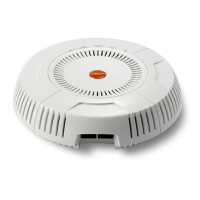Wireless Access Point
214 Configuring the Wireless AP
Understanding Virtual Tunnels
Xirrus APs support Layer 2 tunneling. This allows an AP to use tunnels to
transport traffic for one or more SSID-VLAN pairs onto a single destination
network through the Layer 3 core network. Tunnels may be implemented with:
The Xirrus Tunnel Server (XTS)—see the Xirrus Tunnel Server User’s Guide.
Virtual Tunnel Server (VTS)—see below.
Virtual Tunnel Server (VTS)
Tunneling capability is provided by a Virtual Tunnel Server. You supply the server
and deploy it in your network using open-source VTun software, available from
vtun.sourceforge.net. To enable the AP to use tunneling for a VLAN, simply enter
the IP address, port and secret for the tunnel server as described in Step 12 on
page 219.
VTun may be configured for a number of different tunnel types, protocols, and
encryption types. For use with APs, we recommend the following configuration
choices:
Tunnel Type: Ether (Ethernet tunnel)
Protocol: UDP
Encryption Type: select one of the encryption types supported by VTun
(AES and Blowfish options are available)
Keepalive: yes
VTS Client-Server Interaction
The AP is a client of the Virtual Tunnel Server. When you specify a VTS for an
active VLAN-SSID pair, the AP contacts the VTS. The server then creates a tunnel
session to the AP. VTun encapsulated packets will cross the Layer 3 network from
the AP to the VTS. When packets arrive at the VTS, they will be de-encapsulated
and the resultant packets will be passed to your switch with 802.1q VLAN tags for
final Layer 2 processing. The process occurs in reverse for packets traveling in the
other direction.
We recommend that you enable the VTun keep-alive option. This will send a
keep-alive packet once per second to ensure that the tunnel remains active.

